KTM Freeride E-XC: the electric off-road motorcycle aimed at cornering the market
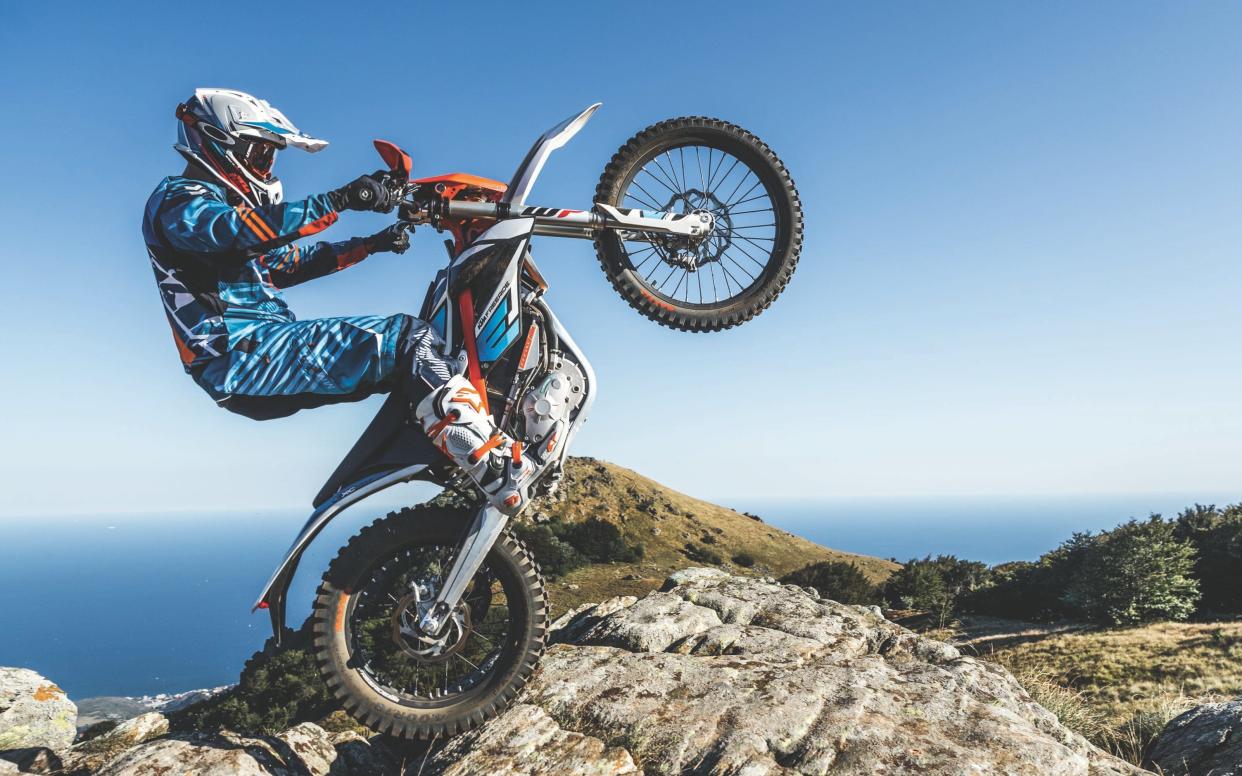
There was a moment during KTM’s presentation of its ambitious, second-generation Freeride E-XC electric off-road motorcycle that was eerily odd. The sound of the future was in fact almost the sound of nothing at all. The shimmering and busy interior of the Hangar 7 facility at Salzburg airport – a Red Bull shrine chock-full of vehicles, racing relics, an F1 car here, motocross and Dakar bikes there, stunt planes regally looking out towards the runway – felt cavernous as Extreme Enduro legend Taddy Blazusiak purred and whined his way down a ramp on the E-XC, through the mass of journalists and KTM guests and up on to the stage; it could be the most delicate, polite and understated introduction of a motorcycle ever.
The Pole parked the lithe, quiet, almost courteous, model next to several members of the KTM Group board of Directors with CEO Stefan Pierer and CSO Hubert Trunkenpolz having held court with Designer Gerald Kiska in front of an international media gathering.
The Austrian brand (also armed with the Husqvarna name since 2013) will register a seventh year of growth in 2017, reaching 1.5 billion euros in sales and setting another new record for units shifted; “a bit more” than 230,000 globally, according to Pierer. KTM has expanded to the point where its modest factory on the outskirts of Mattighofen, close to the German border, has spurted from a few hundred employees to more than 5,500 globally.
KTM’s e-mobility programme is over a decade in the making and its first Freeride production model was released in 2014. The bike was available in off-road and street ‘Supermoto’ versions and apparently sold just over 300 units. “It might not seem a lot but for our first one it means 80% of the market share and makes us the world’s biggest manufacturer of electric motorcycles,” says Trunkenpolz. That market also features names like Zero, Alta, (even Harley-Davidson) and the large section of the forthcoming EICMA show in Milan this week will house a slew of other companies offering electric wares and hoping to entice the curiosity of the bigger players in the industry.
For a relatively minor element of their ballooning motorcycle portfolio the Freeride E-XC (Electric Cross Country) hardly warrants such a lavish location at Hangar 7 and the presence of KTM’s overseers for Blazusiak’s whispering intro. However, there is a wider issue with the technology and KTM’s philosophy towards e-mobility in their products and motorcycling generally (Pierer is also President of the European Association of Motorcycle Manufacturers) and this press event is more than just a technical run-down of another piece of sumptuous orange Austrian machinery.
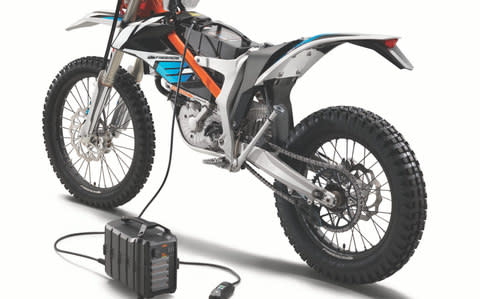
“I am totally convinced that in the future electric mobility has a place in the two-wheeled world,” opines Pierer, a man who revived a bankrupt firm at the beginning of the 1990s, survived the crisis through diversification of their range and aim towards a bigger share of the (reduced) market, and is now leader of a thriving operation that is Europe’s largest and most prolific, pushing towards more intercontinental numbers thanks to co-operation schemes such as their alliance with Indian manufacturer Bajaj.
“E-mobility was something that really grew in mountain bike. To the point where we thought ‘let’s do our own electric off-road competition bike’. We took a couple of years because nobody could really serve or supply us and, to be honest, the total investment in that technology up until now has reached twenty million euros. For us, at that time we were a little company and it was a huge risk. Throughout the crisis we stopped for one or two years but we restarted and launched it three years ago. It was very successful. In the bicycle world more than two-thirds of new sales involve electric bikes and we think it will move up to 3-4KW, so the same as moped/scooter class.”
For KTM, as with most traditional motorcycle manufacturers, the process of embracing battery-power and converting it into a practical and enjoyable bike is the main challenge. “There was no real supply industry for the motorcycle so we had to hire people and specialists; it was a brand new platform for us so it took time…we have always been an innovative company and the Austrian Research Fund helped a lot but seven years is not your usual project time!” remarked R&D Vice President Philipp Habsburg.
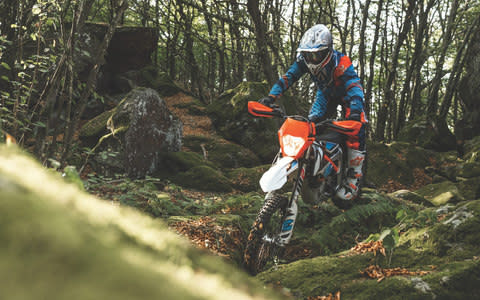
The advantages of the Freeride-E were obvious: zero emissions and noise, low maintenance and the simplistic ‘bicycle’ style of riding with no gearing: just twist and go. The bike was an ideal commuter option or entry port for beginners or a ridiculously light and torquey plaything for experienced riders. By producing off-road and supermoto incarnations (and by navigating logistical and shipping issues that saw the bike delayed for the U.S.) they covered their bases.
In the first months of 2018 the arrival of the Freeride E-XC (a price is still to be set) will hike performance up a notch. The new bike benefits from a Sony cell, a completely reworked chassis and an engine management system that actually allows the battery to recharge while the rider is coasting or braking.
“We did a lot of upgrades to the point where we have now improved the capacity of the battery by 50% because range in e-mobility is one of the key questions,” adds Habsburg. “As always in KTM we try to increase peak performance with the engine and we are close to 25hp and 42 Nm which is the same level as a 250cc two-stroke; the main advantage is that you have that power from 0rpm.”
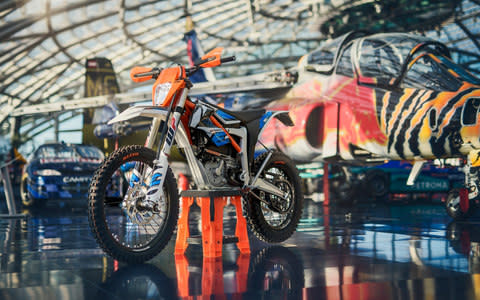
“It is an exciting time for KTM but off-road is still the biggest segment and this is the latest baby in our family,” said Off-Road product manager Joche Sauer on a more general picture. “We have been working more than ten years on e-mobility.”
“The first Freeride-E was more for beginners and this is more for the guy who has already ridden a dirtbike or coming from downhill,” revealed Vice President of R&D Off-Road, Bernhard Plazotta. “An example is the wider handlebars, better brakes and focus on lighter handling.”
At Hangar 7 KTM gave answers, and opened up yet more questions. Will the Freeride E-XC concept really start to catch on? What will this mean for the combustion engine and KTM’s already ferocious four-stroke (and enduring two-stroke, now fuel-injected) technology? How will e-mobility fit into a scale of growth that is chiming in sixth gear for the Austrians?
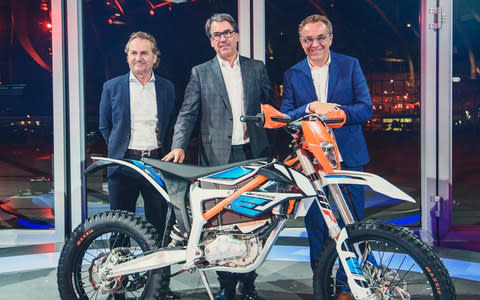
Blazusiak, a stupendously talented motorcyclist, was succinct on how a Freeride E-XC will feel for customers and how his very own ‘toys’ could well change. “The cool thing is that it still rides and performs well,” he says. “I’m an ‘old-school’ guy…but I can understand that this is the future and it is gonna come sooner or later.”
“For designers it is a dream time, so to say, because it means new architecture of bikes and new opportunities,” voices Kiska. “We will see the gap today between a bicycle and a motorcycle disappear and we will see a lot of interesting crossover parts between. This is a opportunity that does not come around every year.”
As efforts in the automobile industry (and Tesla was a name mentioned often at the Hangar 7 proceedings) have discovered, electric engines and vehicles are not without their own lingering doubts and environmental issues but KTM seem to be trying to tackle some of this with their battery policy that involves a cost-friendly leasing scheme.
Once defunct batteries are returned to KTM then an alliance with Saubermacher, an Austrian entity, ensures a recycling process and re-usage: “This means our recycling issue as a manufacturer is solved,” says Pierer.
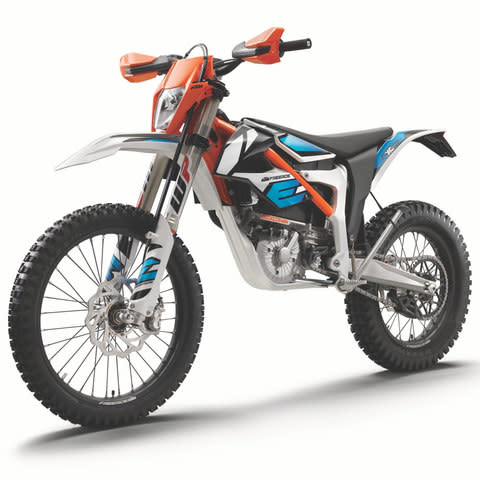
Frustratingly (tellingly?) there are no plans for a road model at this stage (even if the E-XC is completely street legal); Trunkenpolz hinting that another design direction is required. This could be an area for the more experimental sphere of Husqvarna. “For cities we need more things like pillion possibilities and helmet storage,” he explains.
Talk of bicycles, motorcycles of the future and engine power still feel some way down the line. KTM have – and still are – investing in e-mobility but for now it is yet another facet of their comprehensive catalogue. “E-mobility is not for everyone…but it is another possibility for our customers,” says Kiska.
“I think our line of Enduro bikes is a good example,” expounds Trukenpolz. “If you take a look then the consumer is free to pick between a state-of-the-art revolutionarily two-stroke fuel injected engine low on consumption and emissions, the traditional four-stroke engine and now the updated electric. It will depend on the user and their preference and the market will steer by itself. Anyway it is clear that emissions are an issue and we have to bring them down.”
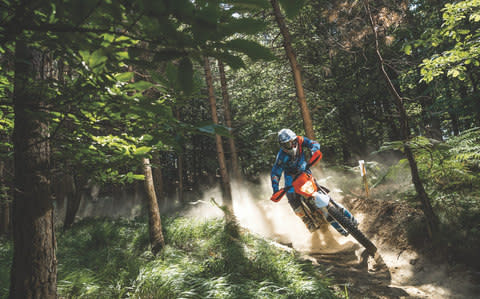
Pierer remains typically bolder but also credits the need for combustion to be the energy source for now: “In my opinion the bridge technology for the next decade is the hybrid. I don't think the combustion engine will disappear for the next 20-30 years.”
“In my opinion the powered two-wheeler is the solution for the future of urban mobility. So we have a clear vision and strategy again from our sport motorcycle programme – off-road or on-road – that we are developing powered two-wheelers on an electric base and we think in ten years time at least 50% of our output will be electric,” he says.
“It is long-term and to afford and achieve that you need a successful and performing combustion programme so you can earn the money to invest in the future.”
As for progress the KTM Group have a lot more on their mind than just current and currency. Over 150 million euros of investment and an emblematic MotoGP racing team raising Street awareness to new levels means the “throttle stays pinned”. Husqvarna is primed to start production of Street machinery in 2018. “Instead of 300,000 sales by 2021 we want 400,000,” Pierer asserts. “We keep the speed, and we want to become a big global player.”
For tips and advice, visit our Advice section, or sign up to our newsletter here

